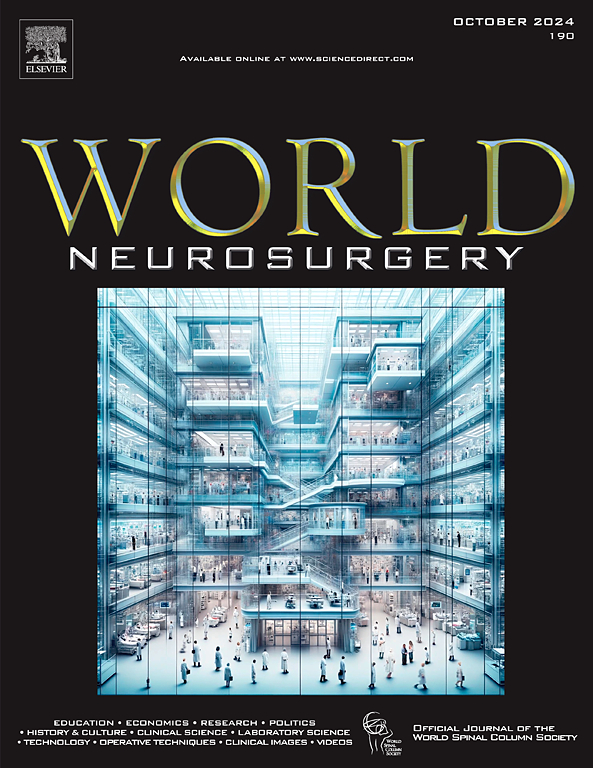Microsurgical Anatomy of Periventricular White Matter from the Endoventricular Perspective
IF 1.9
4区 医学
Q3 CLINICAL NEUROLOGY
引用次数: 0
Abstract
Background
Understanding the spatial disposition of fiber bundles is a requisite for efficient operative planning in cerebral surgery, respecting the most eloquent structures even when not seen by the naked eye. In this study, we used fiber dissection to show critical relationships between the lateral ventricles and white matter fasciculi.
Methods
Twenty cerebral hemispheres obtained from body donation were used to study the lateral ventricles, white matter tracts, and their anatomic relationships. We used a variant of the method described by Ludwig and Klingler for fiber dissection, from inside the ventricular cavity after removing the ependyma.
Results
After removing the ventricular ependyma, adjacent structures were exposed. Corpus callosum fibers form the roof of the lateral ventricle, as well as the anterior wall and floor of the frontal horn. The tapetum, optic radiations, and association fasciculi dominate in the atrium and occipital horn, with distinct fiber orientation patterns. The medial wall of the occipital horn is marked by the presence of the major forceps fibers underneath the bulb of the corpus callosum. The temporal horn walls are characterized by multiple elements, including the hippocampus medially, tapetum fibers laterally and posteriorly, and key neighboring bundles, such as the optic radiations superiorly and the inferior longitudinal fasciculus inferiorly.
Conclusions
Fiber dissection through ependyma removal is an effective method for studying anatomic relationships with adjacent white matter bundles, important for developing a precise anatomic mental picture necessary for effective and safe brain surgery.
从脑室内角度看脑室周围白质的显微外科解剖。
背景:了解纤维束的空间分布是有效的脑外科手术计划的必要条件,即使肉眼看不到,也要尊重最具表现力的结构。目的:在这项研究中,我们使用纤维解剖来证明侧脑室和白质束之间的重要关系。方法:用20个人体捐献的大脑半球,研究侧脑室、白质束及其解剖关系。我们使用了Ludwig和Klingler所描述的方法的一种变体,在去除室管膜后从室腔内部进行纤维剥离。结果:切除室管膜后,显露邻近结构。胼胝体纤维形成侧脑室的顶部,以及额角的前壁和底。心房和枕角以绒毡膜、视辐射和联合束为主,纤维定向模式明显。枕角的内侧壁以胼胝体球下的主要钳纤维为标志。颞角壁具有多种特征,包括海马内侧,外侧和后方的绒毡纤维,以及关键的邻近束,如上视辐射束和下纵束。结论:通过室管膜去除术分离纤维是研究与邻近白质束解剖关系的有效方法,对于建立有效、安全的脑外科手术所需的精确解剖心理图具有重要意义。
本文章由计算机程序翻译,如有差异,请以英文原文为准。
求助全文
约1分钟内获得全文
求助全文
来源期刊

World neurosurgery
CLINICAL NEUROLOGY-SURGERY
CiteScore
3.90
自引率
15.00%
发文量
1765
审稿时长
47 days
期刊介绍:
World Neurosurgery has an open access mirror journal World Neurosurgery: X, sharing the same aims and scope, editorial team, submission system and rigorous peer review.
The journal''s mission is to:
-To provide a first-class international forum and a 2-way conduit for dialogue that is relevant to neurosurgeons and providers who care for neurosurgery patients. The categories of the exchanged information include clinical and basic science, as well as global information that provide social, political, educational, economic, cultural or societal insights and knowledge that are of significance and relevance to worldwide neurosurgery patient care.
-To act as a primary intellectual catalyst for the stimulation of creativity, the creation of new knowledge, and the enhancement of quality neurosurgical care worldwide.
-To provide a forum for communication that enriches the lives of all neurosurgeons and their colleagues; and, in so doing, enriches the lives of their patients.
Topics to be addressed in World Neurosurgery include: EDUCATION, ECONOMICS, RESEARCH, POLITICS, HISTORY, CULTURE, CLINICAL SCIENCE, LABORATORY SCIENCE, TECHNOLOGY, OPERATIVE TECHNIQUES, CLINICAL IMAGES, VIDEOS
 求助内容:
求助内容: 应助结果提醒方式:
应助结果提醒方式:


